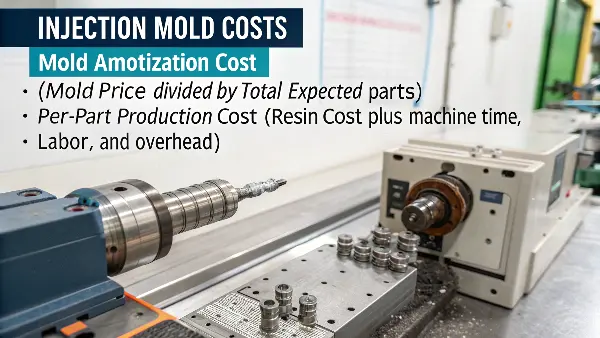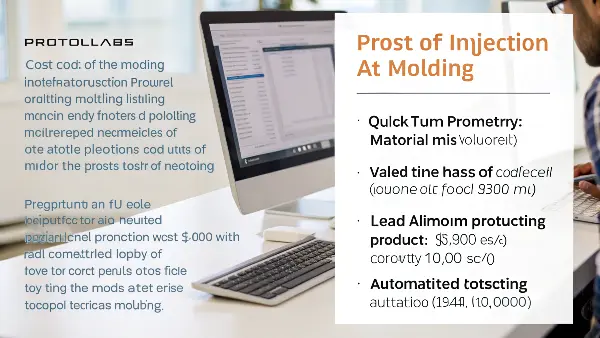Struggling to estimate injection mold costs accurately? Budget mistakes can sink projects before they start, leading to unexpected expenses or compromised quality. Let’s clarify the process for better planning.
Effective budgeting involves understanding cost drivers1 like complexity, size, material, and cavitation for the mold itself, plus per-part costs2 (resin, cycle time) for production, adapting the approach for prototype versus mass production needs.
Planning mold investments3 is crucial, whether you’re making a few prototypes or gearing up for millions of parts. I often work with designers like Jacky to navigate these financial waters, ensuring the budget aligns with the project goals, from initial concept validation right through to full-scale manufacturing. Thinking about cost isn’t just about the first invoice; it’s about the entire lifecycle. Let’s break down how to approach this from start to finish.
How much does it cost to make an injection mold?
Wondering about the price tag for an injection mold? Costs seem all over the place, making planning feel like guesswork. This uncertainty can really derail a project budget quickly.
Injection mold costs typically range from $3,000 for simple, low-volume aluminum tools to over $100,000 for complex, multi-cavity hardened steel molds. Key factors are size, complexity, material (steel grade), cavitation, and required lifespan.
!
Diving Deeper: What Drives the Mold’s Price Tag?
When we quote a mold at CavityMold, several elements contribute to the final price. Understanding these helps you see why one mold might be $5,000 and another $50,000. Here’s a breakdown:
### Part Complexity:This is a major driver. Does the part have intricate geometry, undercuts needing sliders or lifters, tight tolerances, or complex surfaces? More complex parts require more design time, intricate machining, and sophisticated mold actions, significantly increasing cost. Simple, open-and-shut molds are the cheapest.### Mold Size:Larger parts require larger molds, which means more raw material (steel or aluminum) and longer machining times on larger equipment. The physical footprint of the mold base and cavities directly impacts material cost and processing time.### Mold Material:As discussed before, the type of steel (or aluminum) matters hugely.- Aluminum: Best for prototypes or very low volumes (under 10k shots), cheapest material, fastest machining, but low durability.
- P20 Steel: Good for low-to-medium volumes (up to ~400k shots), moderate cost and machinability.
- Hardened Steels (H13, S7): For high volumes (500k+ shots), best durability and wear resistance, but higher material cost, slower machining, and often requires heat treatment, increasing upfront cost.
- Stainless Steels (S136): For corrosive resins or high-polish needs, highest cost.
### Cavitation:How many parts are made in a single cycle (shot)? A single-cavity mold is cheaper to build but slower for production. A multi-cavity mold (2, 4, 8, or more cavities) costs more initially due to complexity and size but reduces the per-part production cost significantly for high volumes.### Tolerances and Surface Finish:Tighter tolerances require more precise machining and quality control. High-gloss finishes (like SPI-A1) need specific steels and extensive, skilled polishing labor, adding considerable cost compared to a standard textured finish.
Thinking about these factors helps explain the wide cost range and allows designers like Jacky to make informed trade-offs between mold features and budget.How to calculate injection molding cost?
Knowing the factors is one thing, but how do you put actual numbers together? Simply guessing based on complexity isn’t enough for a real budget. You need a structured way to estimate.
Calculate total injection molding cost by summing the mold amortization cost (mold price / total expected parts) and the per-part production cost (resin + machine time + labor + overhead).

Diving Deeper: Breaking Down the Calculation
Calculating the true cost involves looking at both the one-time tooling investment and the ongoing cost to produce each part. Here’s how we approach it:
### Mold Cost (Tooling Amortization):- This is the total cost to design and build the physical mold, as detailed in the previous section (material, machining, assembly, etc.). Let’s call this
Mold_Price. - Estimate the total number of parts you expect to produce over the mold’s lifetime (
Total_Volume). - The amortized mold cost per part is
Mold_Price / Total_Volume. This figure decreases significantly as production volume increases. For very high volumes, the mold cost per part becomes minimal.
- This is the total cost to design and build the physical mold, as detailed in the previous section (material, machining, assembly, etc.). Let’s call this
### Per-Part Production Cost:This is the cost incurred every time a part is molded.#### Material Cost:(Weight of part + runner system in kg) * (Resin price per kg). Resin prices vary greatly.#### Machine Time Cost:(Cycle time in seconds / 3600) * (Machine hourly rate) / (Number of cavities). Faster cycle times (enabled by good mold design and cooling) and higher cavitation dramatically lower this cost. Machine rates depend on press size and location.#### Labor & Overhead:Includes operator time for running the press, part inspection, packing, plus factory overhead allocated per machine hour. Automation can reduce direct labor.#### Secondary Operations:Any extra steps like assembly, painting, printing, or special packaging add cost.
### Total Cost Per Part:Total_Cost_Per_Part = (Mold_Price / Total_Volume) + Material_Cost + Machine_Time_Cost + Labor_Overhead + Secondary_Ops_Cost
Understanding this calculation helps Jacky see how decisions about mold design (like adding cavities or choosing steel for faster cycles) impact not just the upfront tooling bill but the final cost of each manufactured part. A slightly more expensive mold might lead to much cheaper parts in high volume.What is the profit margin for injection molding?
Talking about cost naturally leads to questions about profit. Knowing typical margins helps set realistic budget expectations and fosters better supplier discussions. Unrealistic pressure on price can sometimes backfire.
Profit margins vary widely. Mold makers might see 10-25% depending on complexity and competition, while part molders might aim for 15-30% gross margin, heavily influenced by efficiency, volume, and resin costs.

Diving Deeper: Understanding Profitability in the Industry
Profit margins aren’t fixed; they depend heavily on the specific business, project, and market conditions. It’s useful to differentiate between the mold builder and the part producer:
### Mold Maker Margins (e.g., CavityMold):- Competition: Highly competitive markets tend to squeeze margins.
- Expertise & Complexity: Building highly complex, precise molds commands better margins due to the required skill, technology, and lower number of capable competitors. Simple molds face more price pressure.
- Efficiency: Our internal efficiency in design, machining, and assembly directly impacts profitability. Reducing rework and optimizing processes is key.
- Overhead: Investment in good machinery, facilities, and skilled staff represents significant overhead that needs to be covered.
- Risk: Complex projects carry higher risks (e.g., mold needing significant adjustments), which needs to be factored in.
- Value-Added Services: Offering design-for-manufacturability (DFM) analysis or other engineering support can justify better margins. We aim for fair margins that allow us to reinvest in technology and people, ensuring long-term quality for clients like Jacky.
### Part Production Margins (The Molder):- Volume & Cycle Time: High-volume jobs with fast cycle times are generally more profitable due to efficient machine utilization.
- Resin Costs: Fluctuations in polymer prices significantly impact margins, especially on large volume jobs. Locking in prices or passing fluctuations to the client affects this.
- Efficiency & Automation: Low scrap rates, efficient processes, and automation (robotics for part removal, packing) boost profitability.
- Industry: Margins often differ by industry (e.g., medical parts requiring stringent validation vs. simple consumer items).
- Secondary Operations: Complex assemblies or finishing requirements can add value and potentially increase margins if managed efficiently.
Understanding that both mold making and part production require investment, expertise, and risk helps explain why focusing solely on the lowest price might compromise the service, quality, or reliability needed for a successful project.How much does injection molding cost at Protolabs?
You often hear about Protolabs for quick-turn parts. How does their pricing compare, especially for budgeting prototypes versus production runs? It’s a different model, so costs work differently.
Protolabs typically offers rapid prototyping and low-volume injection molding, often using aluminum molds. Their automated quoting system prices based on geometry, material, volume, and chosen lead time; costs reflect speed and their specific process.

Diving Deeper: Protolabs Pricing vs. Traditional Molders
Protolabs has carved out a niche in the rapid manufacturing space, and their pricing reflects their model. While we can’t quote their exact prices (which you get from their online system), here’s how their approach generally compares to a traditional mold maker like CavityMold:
### Protolabs Model:- Focus: Speed is paramount. They excel at delivering functional prototypes and low-volume production parts very quickly (days to a few weeks).
- Technology: Heavy reliance on automation, proprietary software for instant quotes based on CAD analysis, and often standardized mold bases.
- Materials: Primarily uses aluminum molds, suitable for maybe 100 to 10,000+ parts. They offer a curated list of common resins.
- Mold Complexity: Their system is optimized for simpler mold designs. Very complex actions (intricate sliders, lifters, unscrewing mechanisms) might not be feasible or cost-effective through their automated process.
- Pricing: Driven by their automated analysis of geometry complexity, part volume, material choice, and selected lead time. Faster delivery options cost significantly more. The cost reflects the speed and convenience.
### Traditional Mold Maker Model (CavityMold):- Focus: Production tooling, optimizing for long-term value, higher volumes, complex designs, and specific client requirements.
- Technology: Uses advanced CNC, EDM, skilled mold makers, and in-depth DFM analysis. Quotes are typically manual, involving engineering review.
- Materials: Expertise in various steel grades (P20, H13, S7, S136) for molds designed to last hundreds of thousands or millions of cycles. Wide range of resins accommodated.
- Mold Complexity: Capable of handling highly complex part designs with sophisticated mold actions.
- Pricing: Based on detailed cost breakdown (material, machining hours, labor, etc.). Lead times are longer (weeks to months) but optimized for overall production efficiency and tool longevity. Often provides lower per-part cost at high volumes due to durable steel tooling and potentially higher cavitation.
For Jacky, the choice depends on the goal. Need 50 parts next week for a fit check? Protolabs might be ideal. Need 500,000 parts reliably over the next 3 years with a complex design? A traditional molder like CavityMold is likely the better long-term partner. Budgeting needs to consider these different scenarios.Conclusion
Budgeting for injection molds requires looking at the initial tool cost (complexity, material, size) and the ongoing part production cost. Balancing these from prototype to production ensures project success and value.
-
Understanding cost drivers is essential for accurate budgeting in injection molding projects. Explore this link to gain insights into managing costs effectively. ↩
-
Calculating per-part costs is crucial for budgeting in production. This resource will help you understand the factors that influence these costs. ↩
-
Planning mold investments wisely can save you money and improve project outcomes. Discover key considerations to make informed decisions. ↩
